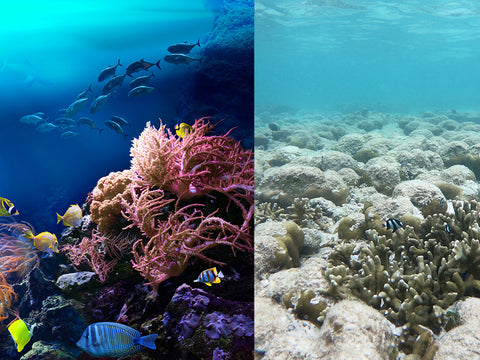With the rate of reef bleaching on the rise, scientists and consumers are urging brands to make more Earth-friendly decisions to save our marine ecosystems.
In a recent study, 90% of coral reefs are expected to experience coral reef bleaching by the year 2050. Although global warming is the leading cause of coral bleaching, our sunscreens have a huge role in contributing to the issue.

In this article, we will dissect some of the misleading marketing tactics used around the term “reef safe” and discuss the importance of cleaning up the ingredient list in your sun-care products. By discussing these topics, we hope to make our world a better place by equipping our readers with the knowledge to make environmentally conscious decisions when creating cosmetic products.
It is crucial to note that the term “reef safe” is not regulated by the FDA, meaning that there are no indicative policies that companies must abide by when using this term in their marketing strategies and package descriptions. The term "reef safe" is typically used to describe mineral-based sunscreens that contain non-nano zinc oxide or non-nano titanium dioxide, however, there are some companies that use the term solely for marketing purposes.
So how do I know what products are actually reef safe?
To answer this question, we must first discuss the attributes and differences between chemical and mineral sunscreens. To legitimately be considered reef safe, sunscreens must be non-nanotized, better known as non-nano. For a sunscreen to be non-nano, the particles within the product must be larger than 100 nanometers (nm). Not only is non-nano sunscreen safer for consumer use since the particles are typically too large to be absorbed into the skin and bloodstream, but they are also the safest option for our marine life.
*Note: Mineral sunscreens that contain non-nano zinc oxide or non-nano titanium dioxide are the only sunscreens notably recognized by the FDA as reef safe.*
It is important to understand that there is a massive difference between non-nano zinc oxide and non-nano titanium dioxide and their nano counterparts. Nano zinc oxide and nano titanium dioxide are very harmful to coral reefs and the body due to its particles that are small enough to get into the skin and our marine life.
Non-nano sunscreens are unanimously considered the safest option by experts, however they tend to leave a white cast on the skin due to the large size of the particles within them. Because of this, many brands opt to disregard environmental safety concerns and formulate chemical and nano sunscreens for what they describe as "performance".
Although the performance and sheer look of chemical sunscreen feels and looks good, some of the ingredients within their formulas are detrimental to overall reef and human health. Oxybenzone, Octinoxate and Octocrylene are some of the harshest ingredients used in sunscreens for coral reefs, and brands should be aware of their negative environmental impact when choosing ingredients to use in their formulations.
Next Steps
Finally, if environmental concerns are either a cornerstone of your business or something your consumers are pushing you towards, it is important to adhere to the ethical guidelines. Although there is no guideline for using the term "reef safe" in products, it is always best to be straightforward with consumers. Consumers are smarter than they were even a couple of years ago. They want to know, they want transparency, and they want their brands to be thoughtful.
If your sunscreen is reef safe, it should be a mineral, non-nano zinc oxide or titanium dioxide formula with nanoparticles that are larger than 100 nm. If a formula claims that it is “reef safe” but has a sheer hue or comes in aerosol packaging, it is most likely absorbable and harmful to marine life. Although there is nothing inherently wrong with formulating and manufacturing chemical sunscreens for performance-based purposes, it is important to understand that they can be harmful in some scenarios.
Many states, including Florida and Hawaii, are making conscious efforts towards promoting reef safe sunscreens. Countries like Australia and Aruba are banning sunscreens containing Oxybenzone and Octinoxate, so there is a growing market and overall need for reef safe sunscreens for brands to manufacture and sell.
So, why not get ahead of the curve and become the staple in the reef-safe movement that is taking over the world. Reach out to us here and we would be happy to answer any questions regarding reef-safe products and ingredients.
